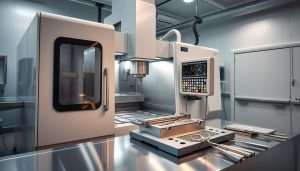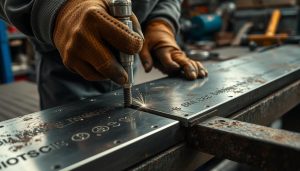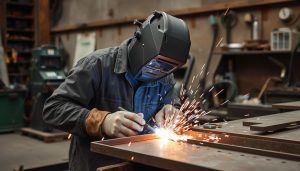Sand blasting, also known as abrasive blasting, is a versatile industrial process that has been widely used for surface preparation, cleaning, and finishing. This powerful technique utilizes pressurized streams of abrasive materials to effectively remove contaminants, smooth surfaces, and enhance the appearance of a wide range of materials. Understanding the nuances of sand blasting is crucial for individuals and industries seeking to optimize their surface treatment and cleaning operations.
In this comprehensive article, we will delve into the intricacies of sand blasting, exploring its various applications, the different types of abrasive materials used, and the safety precautions involved. We will also examine the sand blasting process in detail, highlighting the equipment and techniques employed, as well as the benefits of this technology in manufacturing and maintenance.
What is Sand Blasting?
Sand blasting, also known as abrasive blasting or media blasting, is a surface cleaning and preparation technique that has been widely used across various industries. This process involves propelling a stream of abrasive material, such as sand, glass beads, or metal shots, onto a surface to remove contaminants, improve surface texture, or prepare the surface for further treatment.
Overview of Sand Blasting and Its Uses
Sand blasting is a versatile technique that finds applications in numerous industries, including automotive, construction, aerospace, and metal fabrication. It is commonly used for tasks such as removing rust, paint, or other coatings from surfaces, as well as etching and texturizing materials to enhance their appearance or adhesion properties.
Different Types of Abrasive Materials Used in Sand Blasting
- Sand: The most common and cost-effective abrasive used in sand blasting, providing a rough, matte finish.
- Glass beads: Offer a smoother, more uniform finish compared to sand, often used for delicate surface preparation.
- Aluminum oxide: A harder abrasive that can be used for more aggressive surface cleaning and preparation.
- Steel shot: Ideal for deburring, descaling, and smoothing metal surfaces.
Safety Precautions When Performing Sand Blasting
Proper safety measures are crucial when conducting abrasive blasting operations. This includes the use of personal protective equipment (PPE), such as respirators, safety goggles, and protective clothing, to safeguard operators and bystanders from the potential health and safety risks associated with media blasting activities.
Additionally, ensuring well-ventilated work areas and following industry-standard safety protocols are essential to minimize the exposure to airborne particles and debris generated during the surface cleaning process.
The Sand Blasting Process
Sand blasting is a versatile surface treatment technique that utilizes pressurized air or media to clean, etch, or texture a variety of materials. This captivating process involves carefully controlled abrasion, allowing professionals to transform the appearance and characteristics of surfaces with precision and efficiency.
How Sand Blasting Works: Equipment and Techniques
At the heart of the sand blasting process is specialized blasting equipment, which combines an air compressor, a blast gun or nozzle, and a media hopper containing the chosen abrasive media. Compressed air propels the abrasive particles through the nozzle, creating a focused, high-velocity stream that impacts the target surface. Skilled operators can adjust the air pressure, media flow, and nozzle angle to achieve desired results.
Surface Preparation and Finishing with Sand Blasting
- Sand blasting is often used as a surface treatment to prepare materials for painting, coating, or further processing.
- The process can remove rust, scale, paint, or other contaminants, creating a clean, uniform surface that is ideal for adhesion and the application of finishes.
- Depending on the abrasive media and technique employed, sand blasting can also produce a range of surface textures, from a smooth, matte finish to a coarse, patterned appearance.
Common Materials Treated by Sand Blasting
The versatility of sand blasting allows it to be applied to a wide array of materials, including metals, glass, ceramics, concrete, and plastics. This makes it a valuable tool in industries such as automotive, aerospace, construction, and manufacturing, where precise surface treatment is essential for quality and performance.
| Material | Application |
|---|---|
| Metals | Rust removal, surface preparation for coatings, texturing |
| Glass | Etching, frosting, and decorative effects |
| Concrete | Surface preparation, creating slip-resistant finishes |
| Plastics | Surface roughening for improved adhesion |
By understanding the intricacies of the sand blasting process, professionals in various industries can harness its power to achieve remarkable surface treatment results and unlock new possibilities for their projects.

Benefits of Sand Blasting in Manufacturing and Maintenance
Sand blasting has become an essential tool in the manufacturing and maintenance industries, offering a range of benefits that make it an invaluable asset. From removing stubborn corrosion to preparing surfaces for coatings and adhesives, this versatile process has a profound impact on the quality and longevity of various products and structures.
Rust and Paint Removal
One of the primary advantages of sand blasting is its ability to effectively remove rust and paint from metal surfaces. This is particularly crucial in the automotive and aerospace industries, where maintaining the integrity of the underlying materials is paramount. Sand blasting can strip away layers of corrosion and old paint, revealing a clean, pristine surface ready for further treatment or refinishing.
Smoothing and Texturizing Surfaces
In addition to its corrosion removal capabilities, sand blasting can also be used to create desired surface textures. From smooth finishes to intricate patterns, the process allows manufacturers to achieve the exact surface characteristics required for their products. This is especially useful in industries such as construction and architecture, where specific surface treatments are necessary for aesthetic and functional purposes.
Surface Preparation for Coatings and Adhesives
Preparing surfaces for the application of coatings and adhesives is another key benefit of sand blasting. By removing contaminants and creating a rougher, more porous surface, sand blasting enhances the adhesion and durability of these materials. This is crucial in industries like manufacturing, where a strong bond between the substrate and the coating or adhesive is essential for the product’s long-term performance and reliability.
| Benefits of Sand Blasting | Description |
|---|---|
| Corrosion Removal | Effectively removes rust and old paint from metal surfaces |
| Surface Texturing | Allows for the creation of desired surface finishes, from smooth to intricate patterns |
| Surface Preparation | Enhances the adhesion and durability of coatings and adhesives |
By leveraging the power of sand blasting, manufacturers and maintenance professionals can unlock a wide range of benefits that ultimately contribute to the quality, longevity, and performance of their products and assets. Whether it’s removing corrosion, texturizing surfaces, or preparing for coatings and adhesives, sand blasting is a versatile and indispensable tool in the world of modern manufacturing and maintenance.

“Sand blasting is a game-changer in the manufacturing and maintenance industries, offering unparalleled capabilities for surface preparation and refinement.”
Sand Blasting Equipment and Techniques
When it comes to sand blasting, selecting the right equipment is crucial for achieving the desired results. From choosing the appropriate blasting machines to understanding the differences between manual and automated methods, mastering sand blasting requires careful consideration.
Choosing the Right Sand Blasting Machine
The type of sand blasting machine you choose will depend on the size and scope of your project. Blasting machines come in a variety of sizes and styles, ranging from compact, handheld units to large, industrial-scale systems. Factors such as the abrasive material, air pressure, and nozzle size will all play a role in determining the most suitable machine for your needs.
Manual vs. Automatic Sand Blasting
Automated blasting systems offer a more efficient and consistent approach, with the ability to handle high-volume or repetitive tasks. On the other hand, manual sand blasting allows for greater control and precision, making it a preferred choice for specialized or intricate projects. The decision between manual and professional sand blasting will depend on the specific requirements of your job and the level of expertise of your team.
DIY Sand Blasting vs. Professional Services
While DIY sand blasting can be a cost-effective option for small-scale projects, it is essential to consider the potential risks and safety concerns. Hiring a professional sand blasting service can ensure that the job is done safely and efficiently, with the added benefit of their expertise and specialized equipment.
Ultimately, the choice of sand blasting equipment and techniques will depend on the specific needs of your project and the level of quality and safety you require. By understanding the options available and the pros and cons of each approach, you can make an informed decision that will lead to the best possible outcome.
Common Applications of Sand Blasting
Sand blasting has become an indispensable tool across a wide range of industries, from automotive and aerospace to construction and architectural restoration. Its versatility and effectiveness in transforming surfaces make it a valuable asset in numerous applications.
Automotive and Aerospace Industries
In the automotive and aerospace sectors, sand blasting plays a crucial role in automotive restoration and surface preparation. It effectively removes rust, old paint, and other unwanted materials from vehicle bodies, enabling a smooth and uniform surface for new coatings or finishes. This process is particularly important in restoring classic cars and aircraft, ensuring a flawless appearance and improved aerodynamics.
Metal Surface Treatment and Restoration
Sand blasting is a go-to solution for metal finishing and restoration. It can be used to clean, smooth, and texture metal surfaces, preparing them for further treatment or coatings. This process is often employed in the refurbishment of industrial equipment, architectural elements, and even historical artifacts, helping to preserve their integrity and aesthetic appeal.
Construction and Architectural Applications
In the realm of construction and architecture, sand blasting finds numerous applications. It is commonly used to clean and prepare surfaces for architectural cleaning, removing years of grime, pollution, and weathering from building facades, monuments, and other structures. This process not only enhances the visual appeal of these structures but also helps to preserve their structural integrity by removing potentially damaging materials.
Sand blasting’s versatility and effectiveness have made it an indispensable tool in various industries, from automotive and aerospace to construction and architectural restoration. Its ability to transform surfaces, remove unwanted materials, and prepare them for further treatments has solidified its place as a crucial component in modern manufacturing and maintenance processes.
Why Choose Shixinproto for Your Sand Blasting Needs?
When it comes to professional sand blasting services, Shixinproto stands out as the industry leader. With years of experience and a commitment to excellence, our team of experts delivers unparalleled industrial cleaning solutions and surface preparation expertise. Whether you’re in the automotive, aerospace, or construction industry, Shixinproto is the trusted partner you can rely on for all your sand blasting needs.
At Shixinproto, we understand the importance of precision and safety in sand blasting applications. That’s why we’ve invested in state-of-the-art equipment and cutting-edge techniques to ensure consistent, high-quality results every time. From rust and paint removal to surface texturizing and preparation for coatings, our specialists have the knowledge and skill to deliver exceptional outcomes tailored to your specific requirements.
What sets Shixinproto apart is our unwavering focus on customer satisfaction. We take the time to understand your unique challenges and work closely with you to develop the most effective sand blasting solutions. With our attention to detail and commitment to safety, you can trust that your project is in the hands of true professionals who prioritize your success above all else.





